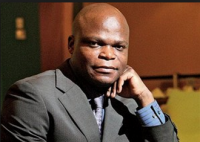










Mulalo Doyoyo (born 13 August 1970) is a South African engineer, inventor, and professor.
Early LIife History
Mulalo Doyoyo was born at William Eddie Hospital in Venda to Khorommbi Doyoyo and his wife Mudzuli (née Dzaga) of Vondwe village. Venda was a bantustan in northern South Africa during apartheid and is now part of the Limpopo Province.
He started his bantu education schooling at Vondwe Lower Primary School in 1977 and then moved on to Tshidimbini Higher Primary School in 1981. He joined Tshidimbini Secondary School in 1984 where he studied until 1985. In 1986, he registered at Mbilwi Secondary School where he founded a science club and a hand-written student newspaper the weekly tri-opinion. He was later voted as the head boy of the school, matriculating in 1988.
Anglo American awarded him a scholarship to study engineering. He chose to pursue his studies at the University of Cape Town. He was enrolled at the university in a five-year engineering bridging program,which at the time was designed for bantu education matriculates. Towards the end of his studies, he was additionally awarded a Shell Oil Company scholarship.
He resided in Smuts Hall, where he became a tutor in science and engineering, eventually becoming a head tutor. He became a publication officer of the student engineering council, a student representative of the South African Institute of Aerospace Engineers, and a founder of the student aerospace society in the faculty of engineering and the built environement.
Eventually, he became the president of the student engineering council. He later created Temescial (technology, medicine, and science for all), an organisation aimed at exposing underprivileged young people in high schools to those fields of learning. Temescial held its first workshop at the University of Venda in 1993.
Doyoyo's honors thesis was on the design and construction of mechanical equipment to investigate false brinelling of heavy-duty bearings in electric motors. Having completed his requirements of a bachelor's degree in mechanical engineering before graduation, he was admitted by Brown University as a visiting undergraduate student, taking graduate courses in solid mechanics, materials science, and applied mathematics. He earned masters' degrees in solid mechanics and applied mathematics in 1995 and 1996, respectively.
Research & career
Applying the foundation and plate theories of structural mechanics, he proved that as an internal reinforcing element, a truss lattice structure has the ability to reduce the weight of a pressure vessel by decreasing its skin thickness while improving its fracture strength. This led to the invention disclosure of microtruss pressure vessels. These pressure vessels accommodate non-round shapes resulting in increased safety, driving range, and cabin space for hydrogen vehicles.
In an effort to develop energy storage systems for large-scale traditional and renewable energy sources, he begun research collaboration with electricity generation companies. As one of the results of this collaboration, he developed Cenocell, a patented concrete-like material that is based on fly ash without the addition of Portland cement.[19] Fly ash is a pollutant byproduct of coal-fired power plants, cement production, paper manufacturing, and mining operations. Cenocell microstructure resembles that of a natural gas reservoir rock.
As of 2006, he became interested in doing research aligning with his homeland's Reconstruction and Development Programme (RDP) He started work with his graduate students on green building and renewable energy. Between 2007 and 2009, he was appointed as a professor extraordinare and later a visiting research and innovation chair at the Tshwane University of Technology. This afforded him the opportunity to collaborate with local researchers on the RDP.
This collaboration inspired him to create Retecza (resource-driven technology concept center). During its inception in South Africa in 2008, the organisation welcomed cross-disciplinary researcher and industrialist participants from around the world. One of the outcomes of Retecza was the design and construction of a hydrogen motorbike named "Ahifambeni".
After leaving Georgia Tech, he moved to Midrand, Johannesburg, where he created an experimental laboratory for environmental-friendly chemicals. Since its founding in 2012, the laboratory has generated several inventions. He also taught mechanical engineering briefly at the University of Johannesburg.Sasol Chemcity recognised the Midrand lab activities and provided funding through its program for small and medium-sized enterprises.
Working in collaboration with concrete manufacturers and mining companies, he developed "green" chemical binders Solunexz and Glunexz for coal dust, construction aggregates, and charcoal. With continued support from Sasol, he developed Amoriguard, a non-volatile organic compound paint and skim coating based on tailings and industrial waste. In 2014, he worked on flushing solar-powered toilets that operate as a miniature waste-treatment plant. This technology based on nanofiltration and anaerobic digestion is implemented in places where water supply and sanitation are scarce.